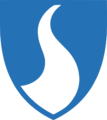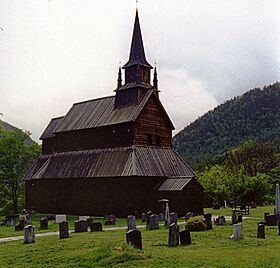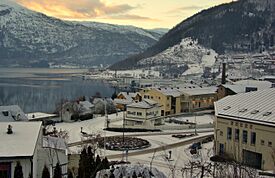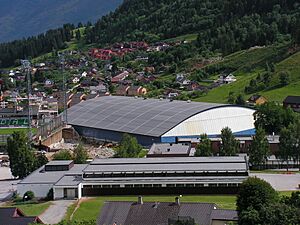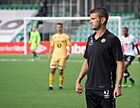Sogndal facts for kids
Quick facts for kids
Sogndal kommune
|
|||||
|---|---|---|---|---|---|
|
Municipality
|
|||||
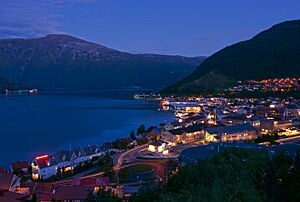
Sogndal by night
|
|||||
|
|||||

Sogndal within Vestland
|
|||||
| Country | Norway | ||||
| County | Vestland | ||||
| District | Sogn | ||||
| Established | 1 Jan 1838 | ||||
| Administrative centre | Hermansverk | ||||
| Area | |||||
| • Total | 1,257.85 km2 (485.66 sq mi) | ||||
| • Land | 1,229.17 km2 (474.59 sq mi) | ||||
| • Water | 28.67 km2 (11.07 sq mi) 2.3% | ||||
| Area rank | #84 in Norway | ||||
| Population
(2023)
|
|||||
| • Total | 12,198 | ||||
| • Rank | #96 in Norway | ||||
| • Density | 9.9/km2 (26/sq mi) | ||||
| • Change (10 years) | 10.2% | ||||
| Demonym(s) | Systrening | ||||
| Time zone | UTC+01:00 (CET) | ||||
| • Summer (DST) | UTC+02:00 (CEST) | ||||
| ISO 3166 code | NO-4640 | ||||
| Official language form | Nynorsk Sognamål (dialect) |
||||
| Created as | Formannskapsdistrikt in 1838 | ||||
|
|
|||||
Sogndal is a municipality in Vestland county, Norway. It is located on the northern shore of the large Sognefjorden. This area is part of the traditional district of Sogn.
The main village and administrative center of Sogndal is Hermansverk. Other villages in the municipality include Kaupanger, Kjørnes, Fimreite, Nornes, and Fjærland. You can find Sogndal Airport, Haukåsen about 10 kilometers southwest of Kaupanger.
The local Norwegian dialect spoken in Sogndal is called sognamål. In 1917, a farmer found the Eggja stone here. This old gravestone has runic writing that is very important for understanding the history of the Old Norse language.
Sogndal municipality covers about 1,258 square kilometers. This makes it the 84th largest municipality in Norway. With a population of 12,198 people, it is the 96th most populated municipality. The population has grown by 10.2% in the last ten years.
Contents
About Sogndal
Sogndal became a municipality on 1 January 1838. Over the years, its borders have changed. On 1 January 1964, a small area called Tingstad joined Sogndal. Later, on 1 January 2000, the Fjærland area also became part of Sogndal. This happened because a new tunnel, the Frudal Tunnel, made it easier to travel between Fjærland and Sogndal.
A big change happened on 1 January 2020. Sogndal merged with Leikanger Municipality and most of Balestrand Municipality. This created a much larger municipality, still called Sogndal. At the same time, the main administrative center moved to Hermansverk. Also, Sogndal became part of the new Vestland county. This new county was formed when Sogn og Fjordane and Hordaland counties merged.
What Does the Name Sogndal Mean?
The name Sogndal comes from the valley name Sóknardalr. The historic Stedje Church was built there. The first part of the name comes from the river Sókn, which is now called Sogndalselvi. The word Sókn means "to seek" or "to look for". So, it means "the river which finds its way". The last part, dalr, means "valley".
The Coat of Arms
Sogndal has had two different coat of arms. The first one was used until 2019. It showed the front part of a Viking ship on a blue background. This ship symbolized the Battle of Fimreite. This battle happened nearby in 1184 between King Sverre of Norway and King Magnus Erlingsson.
A new coat of arms was chosen in 2019 for the larger municipality. It has an S-shaped curve on a blue background. The curve is white and gets narrower towards the top. This design represents a fjord winding between mountains. The S-shape also looks like the first letter of "Sogndal".
Churches in Sogndal
The Church of Norway has six parishes in Sogndal. The main church is Stedje Church. It is one of the oldest church sites in Sogn, possibly built in the 11th century. The current church was built in 1867. An old runestone stands near the church. People have also found signs of a Viking settlement nearby.
Other old church sites include Kaupanger, Norane, and Fjærland. The first churches in Kaupanger and Norane were likely built in the 11th century. In Fjærland, the original church was built around 1600. The current churches in Fjærland and Norane were built in the 1860s.
In Kaupanger, the old Stave church from the 12th century is still standing. It has been restored to look much like it did before 1862.
| Parish (sokn) | Church name | Location of the church | Year built |
|---|---|---|---|
| Balestrand | Kvamsøy Church | Kvamsøy | 1290 |
| Sæle Church | Sæle | 1903 | |
| Tjugum Church | Tjugum | 1863 | |
| Fjærland | Fjærland Church | Fjærland | 1861 |
| Kaupanger | Kaupanger Stave Church | Kaupanger | 12th century |
| Leikanger | Leikanger Church | Leikanger | 1166 |
| Norum | Ølmheim Church | Nornes | 1863 |
| Stedje | Stedje Church | Sogndalsfjøra | 1867 |
History of Sogndal
Sogndal is a very old place where people have lived for a long time. Archaeological digs show that people were here as early as 700 BC. The first farms in Sogndal date back to the 1st century AD. Findings suggest these farms were quite wealthy.
For centuries, agriculture has been the most important activity in Sogndal. Farmers traditionally grew grains and raised animals. Forestry and fruit growing were also common. People have grown fruit, especially apples, here for a very long time. Even in old records from King Sverre in the 12th century, there are mentions of apples being grown in this area.
Sogndalsfjøra: A Growing Center
The largest settlement in Sogndal is Sogndalsfjøra. It has a long history as a community by the sea. It was likely the main center for the area for hundreds of years. It had stores and bakeries, showing its early importance for trade.
This community was always busy. Farmers living along the fjord used its boat landings. Military groups were based here. Later, people rented rooms to the first students of the new folk high school. Important meetings were held at Hofslund, and the church was nearby.
Sogndalsfjøra had people living there as early as the 1600s. By 1701, about 60-70 people lived there permanently. Most of them were day laborers who did not own land. A hundred years later, the population grew to 222. By 1900, 422 residents were registered.
By the late 1800s, more types of jobs appeared. In 1881, there were painters, a goldsmith, carpenters, shoemakers, and a butcher. Ten years later, Sogndalsfjøra had an insurance agent, a telephone operator, a photographer, and a printer. Sogndalsfjøra was becoming a busy center for trade, business, and education.
Sogndal has never been a big industrial town. However, there was a matchstick factory here from the mid-1800s. Later, a wool mill and a factory for bottling soft drinks and fruit juices were added. In 1911, a power station was built. This was one of the first power stations in rural Norway.
On the other side of the river was the Stedje Mill. This mill used water power to grind grain. It was very important for Sogndal and nearby areas in the early 1900s. It opened in 1893 and was used until the 1960s.
Geography of Sogndal
Sogndal is located on the northern shore of the large Sognefjorden. The Sogndalsfjorden branches off the main fjord into the municipality. The northern part of Sogndal surrounds the inner part of the Fjærlandsfjorden.
Mountains divide the municipality. The Frudal Tunnel connects the more populated southern part of Sogndal to the Fjærland area in the north. The Fjærland area is surrounded by mountains and water. The only other way to reach Fjærland is through the Fjærland Tunnel. This tunnel connects to Jølster municipality to the northwest.
Part of the Jostedalsbreen National Park is in the far northern part of Sogndal. The Jostedalsbreen glacier is partly in Sogndal. It has several smaller glacial arms here, like Bøyabreen, Jostefonn, and Supphellebreen.
Sogndal shares borders with several other municipalities. Luster is to the northeast and east. Jølster is to the northwest. Gaular, Leikanger, and Balestrand are to the west. Vik and Lærdal are to the south, across the Sognefjorden.
Climate in Sogndal
Sogndal has different climates because of its varied landscape. At sea level along the Sognefjord, the climate is mild and oceanic. In higher areas, it becomes subarctic. In the very high mountains above the treeline (around 900 meters), it's like an alpine tundra.
Njøs is a weather station near Sogndal town. It has a mild oceanic climate. The wettest months are from September to January. The driest months are from April to August. Average monthly temperatures range from 0.7°C (33.3°F) in February to 16.5°C (61.7°F) in July. The highest temperature ever recorded at Njøs was 32.5°C (90.5°F) in July 2019. The lowest was -17.4°C (0.7°F) in January 1987.
| Climate data for Njøs in Sogndal 1991-2020 (45 m, precipitation days 1961-90, extremes 1957-1990 & 2013-2020) | |||||||||||||
|---|---|---|---|---|---|---|---|---|---|---|---|---|---|
| Month | Jan | Feb | Mar | Apr | May | Jun | Jul | Aug | Sep | Oct | Nov | Dec | Year |
| Record high °C (°F) | 12 (54) |
13.9 (57.0) |
15.2 (59.4) |
20.2 (68.4) |
29.4 (84.9) |
30.3 (86.5) |
32.5 (90.5) |
30.4 (86.7) |
24.4 (75.9) |
20.2 (68.4) |
16.6 (61.9) |
14 (57) |
32.5 (90.5) |
| Daily mean °C (°F) | 0.9 (33.6) |
0.7 (33.3) |
2.7 (36.9) |
6.4 (43.5) |
10.2 (50.4) |
13.8 (56.8) |
16.5 (61.7) |
15.4 (59.7) |
11.8 (53.2) |
7.2 (45.0) |
4 (39) |
1.3 (34.3) |
7.6 (45.6) |
| Record low °C (°F) | −17.4 (0.7) |
−14 (7) |
−12.7 (9.1) |
−7 (19) |
−1.6 (29.1) |
1 (34) |
5.1 (41.2) |
4.5 (40.1) |
−0.3 (31.5) |
−3.5 (25.7) |
−10.9 (12.4) |
−16.5 (2.3) |
−17.4 (0.7) |
| Average precipitation mm (inches) | 113 (4.4) |
88 (3.5) |
82 (3.2) |
53 (2.1) |
42 (1.7) |
55 (2.2) |
73 (2.9) |
71 (2.8) |
107 (4.2) |
106 (4.2) |
102 (4.0) |
127 (5.0) |
1,019 (40.2) |
| Average precipitation days (≥ 1.0 mm) | 13 | 9 | 11 | 7 | 8 | 10 | 11 | 12 | 15 | 16 | 14 | 14 | 140 |
| Source 1: eklima (means, precipitation, extremes - data by met.no) | |||||||||||||
| Source 2: yr.no Njøs climate statistics | |||||||||||||
The Norwegian meteorological office has other stations in the municipality. Fjærland is at the end of a long, narrow fjord. It has less influence from the ocean. It is surrounded by high mountains and Norway's largest glacier. There is also a weather station at Sogndal Airport, located 497 meters above sea level.
| Climate data for Fjærland, Sogndal (2002–2020 averages; extremes since 1938) | |||||||||||||
|---|---|---|---|---|---|---|---|---|---|---|---|---|---|
| Month | Jan | Feb | Mar | Apr | May | Jun | Jul | Aug | Sep | Oct | Nov | Dec | Year |
| Record high °C (°F) | 14.8 (58.6) |
12.0 (53.6) |
14.1 (57.4) |
21.6 (70.9) |
28.7 (83.7) |
30.8 (87.4) |
33.9 (93.0) |
32.8 (91.0) |
24.2 (75.6) |
21.5 (70.7) |
15.7 (60.3) |
13.5 (56.3) |
33.9 (93.0) |
| Mean maximum °C (°F) | 7.7 (45.9) |
7.7 (45.9) |
10.3 (50.5) |
16.7 (62.1) |
23.2 (73.8) |
26.4 (79.5) |
28.6 (83.5) |
26.0 (78.8) |
21.3 (70.3) |
15.6 (60.1) |
11.9 (53.4) |
9.1 (48.4) |
29.2 (84.6) |
| Mean daily maximum °C (°F) | 0.6 (33.1) |
1.6 (34.9) |
5.2 (41.4) |
10.2 (50.4) |
15.3 (59.5) |
19.4 (66.9) |
20.9 (69.6) |
19.4 (66.9) |
14.6 (58.3) |
9.2 (48.6) |
4.2 (39.6) |
1.4 (34.5) |
10.2 (50.3) |
| Daily mean °C (°F) | −2.2 (28.0) |
−1.8 (28.8) |
1.0 (33.8) |
5.2 (41.4) |
9.9 (49.8) |
13.8 (56.8) |
15.7 (60.3) |
14.8 (58.6) |
10.9 (51.6) |
5.8 (42.4) |
1.6 (34.9) |
−1.2 (29.8) |
6.1 (43.0) |
| Mean daily minimum °C (°F) | −4.9 (23.2) |
−5.1 (22.8) |
−3.3 (26.1) |
0.2 (32.4) |
4.5 (40.1) |
8.1 (46.6) |
10.5 (50.9) |
10.1 (50.2) |
7.2 (45.0) |
2.4 (36.3) |
−1.1 (30.0) |
−3.8 (25.2) |
2.1 (35.7) |
| Mean minimum °C (°F) | −15.5 (4.1) |
−16.3 (2.7) |
−12.9 (8.8) |
−6.3 (20.7) |
−2.0 (28.4) |
2.4 (36.3) |
4.7 (40.5) |
3.6 (38.5) |
0.4 (32.7) |
−5.3 (22.5) |
−8.6 (16.5) |
−13.3 (8.1) |
−18.6 (−1.5) |
| Record low °C (°F) | −27.0 (−16.6) |
−23.0 (−9.4) |
−22.5 (−8.5) |
−16.6 (2.1) |
−5.7 (21.7) |
−0.9 (30.4) |
0.7 (33.3) |
0.3 (32.5) |
−3.0 (26.6) |
−15.5 (4.1) |
−18.5 (−1.3) |
−22.5 (−8.5) |
−27.0 (−16.6) |
| Average precipitation mm (inches) | 211.8 (8.34) |
151.4 (5.96) |
162.1 (6.38) |
97.6 (3.84) |
87.3 (3.44) |
82.8 (3.26) |
102.8 (4.05) |
123.5 (4.86) |
204.6 (8.06) |
209.1 (8.23) |
214.7 (8.45) |
250.7 (9.87) |
1,898.4 (74.74) |
| Source: Norsk Klimaservicesenter | |||||||||||||
Economy in Sogndal
Agriculture has always been very important in Sogndal. Historically, businesses here have focused on processing farm and forest products.
Industrial Park and Companies
The Kaupanger Industrial Park is home to several big companies. Lerum Industries A/S makes lemonade, syrup, juice, and jam. It is a very important company in Sogndal and the largest factory of its kind in Norway. Gilde is a meat processing company. It specializes in cured meat products. Together, Lerum and Gilde make up most of the traditional industry in Sogndal. Many public services for the region are also located here.
Fishing and Shopping
You can buy fishing permits for salmon fishing in specific rivers, like Årøy-elva.
Sogndal is the main shopping center for the surrounding region. About 30,000 people live in this area. There are about 70 shops in the center of Sogndalsfjøra. Many of these shops are in a modern shopping mall called Sogningen Storsenter.
Sports in Sogndal
Sogndal has great facilities for both indoor and outdoor sports. You can find many different activities here. On a national level, Sogndal Fotball (soccer) is very well known. They play at Fosshaugane stadium. Sogndal Fotball plays in the Norwegian Second Division, which is the second highest level of Norwegian football. Even though Sogndalsfjøra is small, Sogndal has played many seasons in Norway's top division.
Sognahallen Sports Center
Sognahallen is the main sports arena in Sogndal. It is a modern sports hall. It has a full-sized football field, including fields for team handball. There is also a 100-meter athletics track and an 18-meter high climbing wall. Sognahallen also has a scientific sports center. This center includes a strength training studio, an aerobic hall, and a spinning hall. It works with the Western Norway University of Applied Sciences to offer good facilities for sports education, recovery, and testing.
Fun Places to Visit
- De Heibergske Samlinger – Sogn Folkemuseum and Sogn Fjordmuseum at Kaupanger. Here you can learn about life along the Sognefjord from the 1700s until today.
- Kaupanger stavkyrkje - This is the biggest Stave church in the Sognefjord region. It was built around 1190.
- Norsk Bremuseum in Fjærland – This is an award-winning museum where you can learn about snow, ice, and glaciers through hands-on activities.
- Den norske bokbyen in Fjærland - This is a "book town" with many second-hand bookshops, antique stores, and book cafes.
Famous People from Sogndal
Public Service & Important Thinkers
- Melchior Falch (1720–1791), a lawyer and promoter of fisheries.
- Niels Johannesen Loftesnæs (1789–1848), a farmer and soldier who helped write the Norwegian Constitution.
- Hans Paludan Smith Schreuder (1817–1882), a missionary to the Zulu Kingdom.
- Jens Andreas Friis (1821–1896), a professor and important linguist for the Sami languages.
- Andreas Leigh Aabel (1830–1901), a Norwegian doctor and poet.
- Harald Sverdrup (1888–1957), an oceanographer and director of the Norwegian Polar Institute.
- Liv Signe Navarsete (born 1958), a well-known politician and former minister.
Artists & Musicians
- Gjest Baardsen (1791–1849), a famous outlaw, writer, and songwriter.
- Minda Ramm (1859–1924), a Norwegian novelist and translator.
- Olav Stedje (born 1953), a Norwegian soft rock singer-songwriter.
- Tone Damli Aaberge (born 1988), a Norwegian singer-songwriter and actress.
- Windir (1994–2004), a Norwegian metal band from Sogndal.
- Eva & The Heartmaker (formed 2006), a music duo.
Sports Stars
- Eirik Bakke (born 1977), a retired football player who played many games for Norway.
- Thea Bjelde (born 2000), a football player with many games for the Norway women's team.
- Terje Skjeldestad (born 1978), a retired goalkeeper for Sogndal Fotball.
- Anders Stadheim (born 1980), a former football player.
- Oddbjørn Skartun (born 1989), a Norwegian football player.
- Kristian Opseth (born 1990), a Norwegian football player.
See also
 In Spanish: Sogndal para niños
In Spanish: Sogndal para niños


